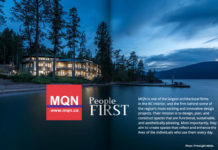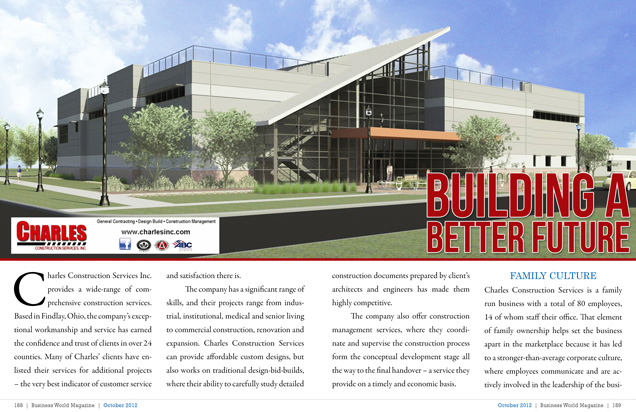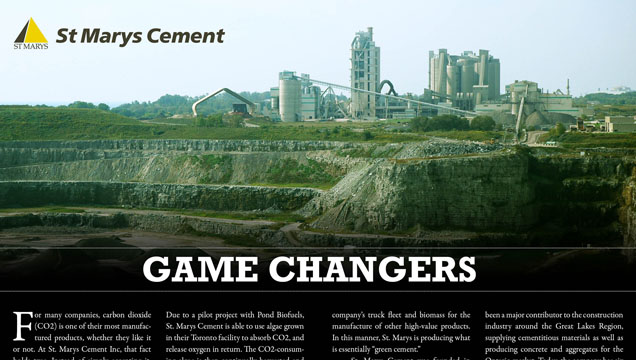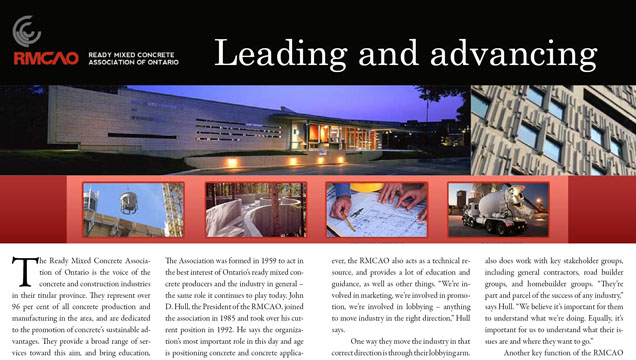
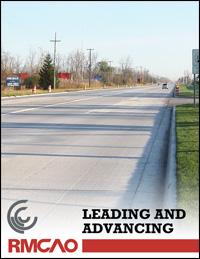
Leading and advancing
The Ready Mixed Concrete Association of Ontario is the voice of the concrete and construction industries in their titular province. They represent over 96 per cent of all concrete production and manufacturing in the area, and are dedicated to the promotion of concrete’s sustainable advantages. They provide a broad range of services toward this aim, and bring education, research and innovation to the industry and their members.
The Association was formed in 1959 to act in the best interest of Ontario’s ready mixed concrete producers and the industry in general – the same role it continues to play today. John D. Hull, the President of the RMCAO, joined the association in 1985 and took over his current position in 1992. He says the organization’s most important role in this day and age is positioning concrete and concrete applications as being sustainable.
Beyond that very important goal however, the RMCAO also acts as a technical resource, and provides a lot of education and guidance, as well as other things. “We’re involved in marketing, we’re involved in promotion, we’re involved in lobbying – anything to move industry in the right direction,†Hull says.
One way they move the industry in that correct direction is through their lobbying arm. The association is involved in lobbying both municipal and provincial governments, and also does work with key stakeholder groups, including general contractors, road builder groups, and homebuilder groups. “They’re part and parcel of the success of any industry,†says Hull. “We believe it’s important for them to understand what we’re doing. Equally, it’s important for us to understand what their issues are and where they want to go.â€
Another key function of the RMCAO is providing a world class plant certification to all its members.  “In order to be a member of the Ready Mix Concrete Association, the active member’s facilities must pass a facility certification,†Hull explains. “This certification we’ve had for many, many years – as far back as the 60s – and it has gone through its improvements. It would be what I refer to as the most stringent certification program in North America.â€
Their certification is third party engineered so as to remove conflict of interest, and Hull says it has been specified by a growing number of general contractors, municipalities, and government agencies. “People want more insurance as time goes on, so this is a good thing for them to do.â€
In 2009, the RMCAO developed an ECO certification program. As of now, that program is voluntary, but that will change in 2013 and beyond. “This is a program that we looked at as really part of a statement,†Hull says. “We want to be environmentally responsible.†The certification itself is made up of two parts. The first part ensures the certified facility complies with regulations put forth by Ontario Ministry of Environment. The second part assesses things like how effective a facility is in multiple environmentally related categories – categories like Recycling, Sustainable Sites, Energy Conservation, and more. “We started the certification because people want to build green, and at some point they’re going to say ‘Oh, and by the way, the people that I buy from, I want them to be green too,’†Hull explains. Responsible Materials Procurement is important from an owners’ perspective and ECO goes a long way to address it.
“The culture at the association at a board level is that ‘the status quo is not good enough,’†he continues. “We have to ask ourselves some questions: ‘What do we stand for? Where do we really want to go in this industry, what do we want the association to mean, and what can we do for the membership?’ The answer is we really want the association to lead and advance.†In order to do that, the RMCAO as a whole decided they needed to take more substantive measures when it came to preserving the environment.
“You can’t pay it lip service,†Hull adds. “We want concrete to maintain its status as a really good building material of choice. We don’t want to lose market to steel, and we want to capture the concrete paving market. We see the sustainable aspects of concrete and concrete pavement as the way to all that – it’s just the way the board wanted to move.â€
Unfortunately, putting those sustainable measures into effect can be a challenge. The concrete industry itself is a reactive one, so if a specification calls for something it can respond overnight. Government, on the other hand, does not have the same flexibility. “The biggest roadblock is government,†Hull says plainly. “It’s those who say they want to be green, but aren’t quite ready to be green or know how to take advantage of some of the opportunities.â€
A large factor behind government inertia is what Hull calls ‘cross coverage’. For example, paving a road with concrete instead of asphalt might be advantageous to the Ministry of Natural Resources because it would mean less aggregate being used. The Ministry of Transport – the people responsible for making roads – does not benefit directly, however, so they are slow to react. “You say ‘It’s saving aggregate, it’s sustainable, it makes the reserves last longer – all of which is important to the Ministry of Natural Resources,’†Hull explains. “But the Ministry of Transport says ‘but what’s in it for the MTO?’†Working around cross coverage is a constant challenge for the association.
Pavements have been a heavy focus for the RMCAO in the past few years. The National Resource Council (NRC) did a recent study on them, and found concrete had an advantage over asphalt because it was harder, and did not deflect as much, resulting in fuel savings for heavy trucks. “We took a 183 kilometre section of road from London to Toronto,†Hull says, recalling an experiment the association conducted. “We calculated that 183 kilometres would save 70 million litres of diesel fuel a year.†In terms of the price of gas, that would save more than 72 million dollars, and also equate to 186,000 metric tonnes of carbon dioxide (CO2) reduction – roughly 1,000 metric tonnes a kilometre – every year.
“And the Ministry of Transport said: ‘So?’†Hull says.
Additionally, a concrete road is also more light reflective than asphalt, which means roads could use 30 per cent fewer light standards, which would also save 30 per cent on electricity, which in turn would reduce CO2 emissions. “Again,†Hull says. “It’s: ‘so what?’â€
“It’s just a win, win, win, all the way along,†he continues. The challenge is increasing awareness and understanding among all stakeholder groups.
Another factor behind government inertia is simply their unwillingness to try something different. “They don’t have to,†Hull says. “They have little or no impetus to change, therefore why would they change? But we keep working on it, and we have dedicated people working with concrete pavement.†They have already got the Ministry of Transport to accept concrete bids on highways, something they never used to do. In the future, Hull hopes they keep moving in that direction. The RMCAO will certainly never give up encouraging them.
“We want a strong industry, we want a strong product, and we want them both to mean something,†Hull concludes. With the RMCAO as the industry’s voice, they have a very good chance of getting exactly that.



